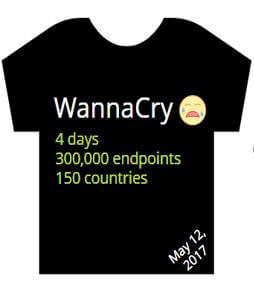EXECUTIVE SUMMARY:
Four days, 300,000 endpoints, 150 countries. Been there, done with that, got the t-shirt.
Believe it or not, two years after the initial scare, WannaCry still haunts businesses day in and day out. Since the virus’s debut appearance on May 12th 2017, 4,826,682 variants of the malware have been detected.
While many organizations launched into action immediately and undertook massive new security initiatives, the reality is that “…hundreds of thousands of systems globally are still vulnerable to EternalBlue and EternalRomance, exploits that WannaCry used to propagate and spread.”
Research indicates that the threats presented by WannaCry have dipped, but numbers are still in the six figure range, reports the director of Malwarebytes Labs, Adam Kujawa. Interestingly, U.K based security researcher, Kevin Beaumont, presents different viewpoint, suggesting that the WannaCry threat is “largely neutered,” as it’s no longer able to pack and encrypt data.
Early hackers deploying WannaCry typically hounded after bitcoin, demanding $300 to $600 worth of bitcoin per compromised system. But the bounty that’s in vogue has changed. These days, most hackers chase data.
Your finances and your business’s finances are valuable, but your intellectual property might be worth even more. Moving data (aka valuable intellectual property) into the cloud is the norm for many businesses, and experts predict a surge in threats targeting cloud assets. “We’re already seeing this with the rise in attacks on poorly configured cloud databases and clusters of containers,” writes Threatpost.
Get the full story at Threatpost.com.




